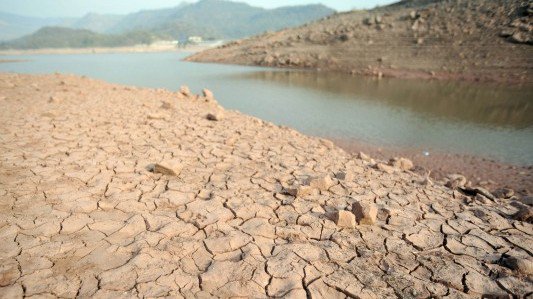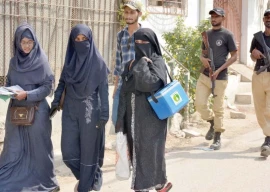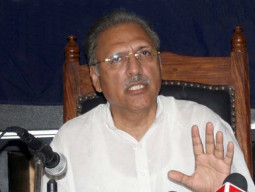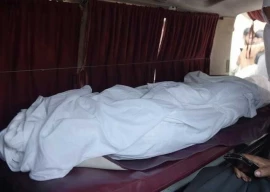
However, in the face of this ever-mounting demand, Karachi has for many years not even received the share of water approved for it. And this continuously widening gulf between supply and demand has culminated in the worst water crisis the city has experienced in a decade.
Under its approved share, Karachi should receive 750 millions of gallons per day (MGD) from the Indus River and the Hub Dam. Due to problems with the Karachi Water and Sewerage Board’s (KWSB) water distribution system and the lack of capacity at the Dhabeji Pumping Station, Karachi receives just 580 MGD.
That is not all, however. Over 30% of the water that Karachi does get is wasted day in and day out, leaving the city with just 406 MGD.
Persistent negligence on both the Sindh government and KWSB’s part means Karachi’s water supply system could not be fixed, much less improved or upgraded in the last 13 years. Meanwhile, grand schemes to meet Karachi’s demand for water, like the K-IV Karachi Bulk Water Supply project, remain stuck in development hell.
Residents in Rawalpindi decry water shortage
Who gets the water?
Although no comprehensive data exists on how much water Karachi’s domestic, commercial and industrial sectors receive due to the weak structure of the city’s water distribution, it is estimated that the KWSB supplies 355.5 MGD to domestic consumers and 32.5 MGD to industrial and commercial sectors.
Another 18 MGD is supplied to residential and commercial areas by various water tanker services, according to estimates - 10 MGD to the latter and 8 MGD to the former. Consequently, Karachi receives about 363.5 MGD for domestic consumption and 42.5 MGD for commercial and industrial sectors.
While most of the city’s bulk water consumers have meters installed, residential and commercial areas in all six districts receive their supply without any meter. In the absence of meters, the volume of water consumed is determined via a formula that factors in the dimensions of the water pipe and the speed and duration with which the water is supplied.
“It is very difficult to get correct readings off of meters installed for bulk consumers given how inadequate the KWSB water supply system is,” admitted a KWSB engineer, speaking on condition of anonymity.
“Meters are only installed for commercial and industrial sectors, federal and provincial government institutions, residential areas of the Defense Housing Authority (DHA), cantonment boards, private housing societies, high-rise buildings and government residential colonies,” the engineer said.
He added that bulk consumers receive 126 MGD through the pipeline system, while the remaining residents dwelling in 18 towns of the city across six districts are provided 262 MGD without any meters.
Karachi likely to face water crisis during Eid holidays
If bulk consumers are divided into commercial and residential area consumers, then commercial and industrial sectors are supplied 32.5 MGD while residential areas get 93.5 MGD.
Although Sindh Chief Minister Murad Ali Shah recently called a meeting of all stakeholders to discuss Karachi’s water crisis, according to sources, questions as to why the city’s water supply could not be improved and who should be held responsible were not even discussed.
Under former president Pervez Musharraf’s regime, then Karachi nazim Mustafa Kamal completed the K-III project, which supplies 100 MGD, with the federal government’s help. Since then, however, no other water project has been completed, even the plan to increase the Dhabeji station’s capacity by 65 MGD. What’s more, repair and construction work at the Hub Canal did not begin at all.
The supply
According to documents available with The Express Tribune, Karachi receives only 494 MGD of its 650 MGD share from Keenjhar Lake due to shortage of capacity at the Dhabeji station, which manages 450 MGD.
To increase supply from the lake, a 13-kilometre pipeline must be installed to connect Siphon 1 to the Dhabeji station. Even the PC-1 for this project has not been completed.
And while Karachi has received 100 MGD from Hub Dam for the first time in four years due to a rain-driven increase in water levels, a huge amount of water has been wasted due to the Hub Canal’s deteriorating condition. Citizens are also deprived of a huge volume of water due to low pressure in the KWSB distribution system.
Speaking to The Express Tribune, KWSB Managing Director Asadullah Khan insisted that various efforts to improve Karachi’s water supply system are underway.
“We know Karachi is experiencing severe water shortage and work to enhance Dhabeji Pumping Station’s capacity is underway at a fast pace,” he said, claiming that, “The reviewed PC-1 has been sent for Sindh government approval and the project will be completed this September and add 40 MGD to the city’s supply.”
Residents of Nusrat Bhutto Colony protest water shortage
Admitting that 30% of the water supplied through the Indus and the Hub Dam is wasted, Asadulluh maintained that remaining development works will begin soon as well and “attempts will be made to complete them on time.”
He said that the Local Government Minister Saeed Ghani is taking a special interest in the completion of the water supply projects.
“On his directives, the PC 1 for installing a 13-kilometre transmission line is being drafted in order to enhance the supply of water from Siphon 1 to the Dhabeji Pumping Station. The project proposal will be sent to the Sindh government for approval by July 30.”
“We expect and hope that the government will release the required funds for the project soon after which the project will immediately commence. We are also trying to control the loss of 30% of the water in cooperation with the World Bank,” he added.
Published in The Express Tribune, July 29th, 2019.

















COMMENTS (1)
Comments are moderated and generally will be posted if they are on-topic and not abusive.
For more information, please see our Comments FAQ